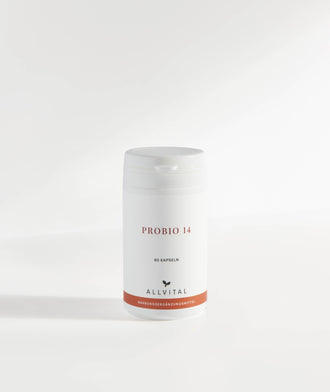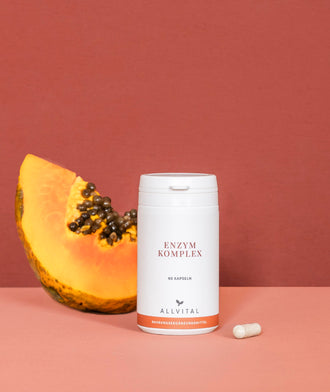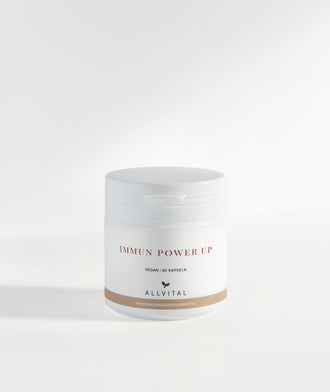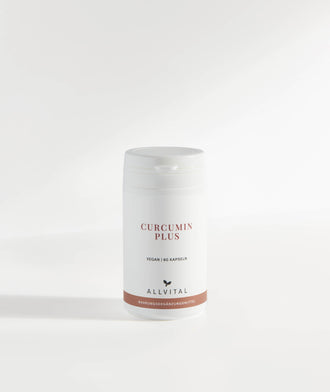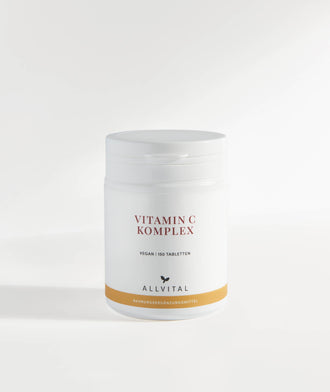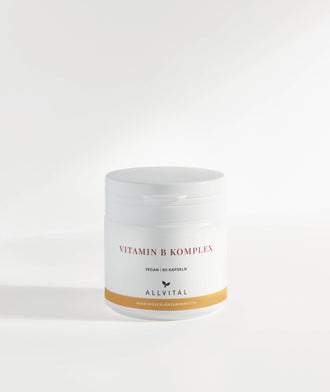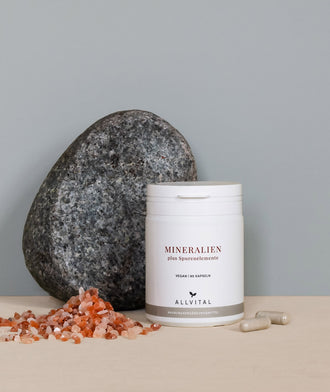
Histamine intolerance: Causes, symptoms, and ways to find relief
Histamine intolerance often goes undiagnosed, even though it can significantly affect a person’s quality of life.
Learn what’s behind this condition, which symptoms are common, and how targeted nutrition can help manage it.
What is histamine intolerance?
Histamine intolerance is a reaction of the body to an excess of histamine. This surplus occurs when histamine—either consumed through food or produced within the body—cannot be broken down efficiently. In other words, there is an imbalance between histamine intake or production and its degradation.
The causes can be either genetic or acquired over time. The symptoms often resemble those of an allergy or a food sensitivity, which can make diagnosis challenging.
What is histamine and what role does it play in the body?
Histamine is a biogenic amine and functionally classified as a tissue hormone. These substances play crucial regulatory roles in the body, often acting locally—directly in the tissue where they are released.
Key functions of histamine include:
- Regulating inflammatory responses and immune function
- Stimulating stomach acid production for digestion
- Dilating blood vessels and increasing their permeability
- Constricting the bronchi
- Acting as a neurotransmitter in the central nervous system (e.g. influencing the sleep-wake cycle)
Histamine is present throughout the human body, with particularly high concentrations found in the skin, respiratory tract mucosa, and the gastrointestinal lining.
Common symptoms of histamine intolerance
The symptoms of histamine intolerance vary widely and can differ significantly from person to person. Since histamine is involved in many bodily functions, the symptoms often affect multiple organ systems at once.
Common symptoms include:
- Skin reactions: flushing, redness, itching, hives (urticaria), welts
- Respiratory symptoms: runny nose, swollen nasal mucosa
- Digestive issues: bloating, diarrhea, abdominal pain, nausea
- Neurological symptoms: headaches, migraines, dizziness, sleep disturbances, fatigue
In individuals who suffer from seasonal allergies like hay fever alongside histamine intolerance, symptoms may intensify and exacerbate one another. You can find more detailed information on this topic in our article “Naturally against hay fever”.
Histamine absorption and breakdown
To understand the causes of histamine intolerance, it's important to look at how histamine enters the body and how it is broken down. An imbalance between absorption and degradation ultimately leads to the wide range of symptoms experienced by those affected.
How does histamine enter the body?
Histamine can enter the body in two ways:
1) Endogenous production
The body produces histamine from the amino acid histidine. This occurs primarily in certain immune cells known as mast cells and basophil granulocytes. These cells store histamine and release it when needed—for example, during allergic reactions or inflammatory processes.
2) Dietary intake
In addition to the body’s own production, histamine can also be ingested through food. Particularly high amounts are found in aged or long-stored foods such as matured cheeses, fermented products, or cured meats.
How is histamine broken down?
The body uses two specialized enzymes to break down excess histamine:
- Diamine oxidase (DAO): This enzyme is mainly responsible for breaking down extracellular histamine—meaning histamine that enters the body through food. DAO is primarily produced by the cells of the intestinal lining and works in both the gut and the bloodstream.
- Histamine-N-methyltransferase (HNMT): In contrast to DAO, HNMT breaks down intracellular histamine, which is produced within the body. This enzyme is active in various tissues, especially the liver, kidneys, bronchial mucosa, and central nervous system.
If the activity of these enzymes is reduced, histamine can accumulate in the body.
Causes and triggers of histamine intolerance
The causes of histamine intolerance are varied and can differ from person to person. Below, we highlight the most important contributing factors.
Reduced DAO activity
One of the most relevant causes of histamine intolerance is reduced activity of the enzyme DAO, which is responsible for breaking down histamine from food.
Possible reasons for reduced DAO activity include:
- Genetic predisposition: Some people are born with reduced DAO activity and are therefore less able to tolerate histamine from food.
- Medications: Certain drugs, including painkillers, antibiotics, and antidepressants, can inhibit DAO (1).
- Intestinal diseases: Chronic intestinal conditions such as Crohn’s disease, celiac disease, or leaky gut syndrome can impair DAO production (2).
- Micronutrient deficiency: DAO requires certain micronutrients, such as vitamin C, vitamin B6, and copper, to function properly (2). These substances act as cofactors (helper molecules) for the enzyme.
Histamine-rich foods
A diet high in histamine increases the likelihood of histamine intolerance symptoms, as the tolerable dose of the substance is more easily exceeded. Even individuals with normal degradation capacity may experience intolerance reactions if too much histamine is consumed.
Histamine-rich foods include:
- Aged cheeses (e.g. Parmesan, Gouda, Camembert)
- Cured and smoked meats (e.g. salami, ham)
- Fish products (especially canned fish)
- Fermented foods (e.g. sauerkraut, kimchi, soy sauce)
- Alcoholic beverages, especially red wine
In addition to histamine-rich foods, there are other foods that can influence histamine metabolism. Some foods contain little or no histamine themselves but can trigger its release from mast cells. These foods are known as histamine liberators. Examples include citrus fruits, tomatoes, strawberries, chocolate, and nuts.
There are also foods that contain other biogenic amines that compete with histamine for degradation and can therefore increase the overall histamine burden. These include bananas, avocados, tomatoes, and eggplants.
Histamine production in the gut during dysbiosis
Another factor that can contribute to histamine overload is increased histamine production in the gut by certain bacteria (e.g. Morganella morganii, Hafnia alvei, Klebsiella pneumoniae) and fungi in the context of dysbiosis (microbial imbalance in the gut) (3).
Additional contributing factors
Other factors that can exacerbate histamine intolerance include:
- Chronic inflammation and increased mast cell sensitivity
- A weakened or dysregulated immune system
- Heavy metal exposure and general toxin burden
- A stressed or fatty liver
- Hormonal imbalances
Diagnosing histamine intolerance
Diagnosing histamine intolerance is not straightforward, as there is no single definitive medical test. A low-histamine diet over several weeks combined with symptom tracking is often the most reliable method to identify the intolerance.
If histamine intolerance is suspected, it’s essential to consult a holistic doctor or practitioner, as multiple contributing factors often coexist. Diagnostic tools may include measuring DAO levels in the blood, histamine levels in the stool, and a microbiome analysis. While these tests can provide valuable insights, they are not sufficient on their own to confirm the diagnosis.
Treatment options
Histamine intolerance, if not genetically determined, is often not a permanent condition and can significantly improve—or even resolve—through targeted, holistic approaches.
Treatment typically includes dietary changes and gut restoration, support for the body’s detoxification processes, and strengthening of the immune system. Correcting micronutrient deficiencies based on individual blood test results is also fundamental. Depending on one’s health status and the root causes identified, additional therapeutic measures may be needed.
Dietary changes and gut restoration
A crucial first step is avoiding foods that are particularly high in histamine or that may otherwise elevate histamine levels (see section "Histamine-rich foods").
Inflammatory foods should also be eliminated. These include highly processed products, refined sugar, white flour, alcohol, and fried foods, all of which can damage the intestinal barrier and impair immune function.
Instead, the focus should be on a wholesome, fiber-rich diet with fresh vegetables, legumes, healthy fats (e.g. from nuts, seeds, and high-quality oils), and quality protein sources. This type of diet promotes the growth of beneficial gut bacteria and helps reduce inflammation in the body.
In addition to dietary adjustments, high-quality supplements can help strengthen the gut microbiome and intestinal barrier—ultimately supporting DAO production in the gut.
Allvital Products for a Healthy Gut:
- ProBio 14: A premium probiotic with 14 selected bacterial strains combined with valuable fibers such as inulin and fructooligosaccharides.
- Enzyme Complex: A blend of digestive enzymes to support the gastrointestinal tract and improve nutrient absorption.
Strengthening the immune system
A strong immune system helps the body regulate histamine more effectively. Key strategies to support immune function include reducing stress, getting sufficient and restorative sleep, regular physical activity, and minimizing exposure to toxins in daily life.
Targeted supplementation can further support the immune system:
- Immun Power Up: A balanced blend of vitamins, minerals, and plant extracts that strengthens the immune system and counteracts oxidative stress.
- Curcumin Plus: A plant-based antioxidant complex with curcumin, quercetin, and grape seed extract.
Enhancing the body’s natural detoxification
Detoxification—especially via the liver—plays a crucial role in breaking down and eliminating histamine. A well-functioning liver can efficiently process excess histamine, reducing intolerance symptoms.
A nutrient-dense diet, adequate hydration, and targeted detox-supportive supplements can optimize this process. For more details, see our article “The Liver – the multitasker of our body”.
Supporting DAO activity
In cases of genetically determined DAO deficiency—or for short-term support in non-genetic cases—DAO supplements can be helpful. These over-the-counter products can be taken with histamine-rich meals.
It may also be beneficial to supplement the cofactors needed for DAO function. However, no study has yet demonstrated a direct effect of these cofactors in treating histamine intolerance.
The following products from our range contain DAO cofactors:
- Vitamin C Complex: Contains various natural forms of vitamin C for optimal absorption and long-lasting support.
- Vitamin B Complex: Provides all essential B vitamins in high doses.
- Minerals and Trace Elements: Supplies the body with copper, zinc, and other minerals and trace elements that act as cofactors in many enzymatic processes.
Why antihistamines should not be used long-term
Antihistamines are medications that block the effects of histamine by binding to its receptors. While they can provide short-term symptom relief, they are not suitable for long-term use.
Antihistamines disrupt the natural balance of histamine in the body, including its role in the central nervous system, where histamine acts as an important neurotransmitter. By interfering with this function, antihistamines can lead to fatigue and concentration issues. These side effects are less pronounced in newer medications but still present.
Therefore, antihistamines should be seen as emergency aids—not a long-term or root-cause treatment.
Conclusion
Histamine intolerance is often manageable. Through mindful nutrition, a healthy gut microbiome, a strong immune system, and other holistic measures, the body’s ability to metabolize histamine can be significantly improved.
Sources
- Leitner R, Zoernpfenning E, Missbichler A. Evaluation of the inhibitory effect of various drugs / active ingredients on the activity of human diamine oxidase in vitro. Clin Transl Allergy. 2014;4(Suppl 3):P23. Published 2014 Jul 18.
- Smolinska S, Jutel M, Crameri R, O'Mahony L. Histamine and gut mucosal immune regulation. Allergy. 2014;69(3):273-281.
- Histaminbelastung. IMD Labor Berlin [Internet]. [aufgerufen am: 30.03.2025].


